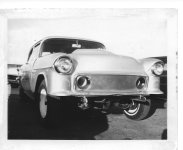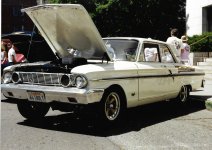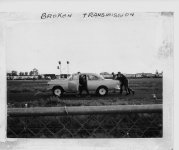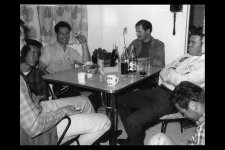You are using an out of date browser. It may not display this or other websites correctly.
You should upgrade or use an alternative browser.
You should upgrade or use an alternative browser.
We Haven't Had A Good Car Thread In A While...........My '67 Chevelle
- Thread starter jackie schmidt
- Start date
Dave Coots
64 Chevy 409 10.42 129
Z11
One of 50 produced in 1963. This is one of the restored original cars. Dave Cobert drove this one back in the day, see name on side. There were 3 or 4 of the guys at Dragway 42 last year that piloted these cars. I don't play well on this site posting pics.
One of 50 produced in 1963. This is one of the restored original cars. Dave Cobert drove this one back in the day, see name on side. There were 3 or 4 of the guys at Dragway 42 last year that piloted these cars. I don't play well on this site posting pics.
Attachments
Dave Coots
64 Chevy 409 10.42 129
Don Powell
He drove 4 hours or so to get to Dragway 42 last year to watch the 409's race. He took my car for a warm up lap around the pits. Brought back memories of him racing his 62 409 back in the day. He said he burnt off a set of tires in 2 weeks.
He drove 4 hours or so to get to Dragway 42 last year to watch the 409's race. He took my car for a warm up lap around the pits. Brought back memories of him racing his 62 409 back in the day. He said he burnt off a set of tires in 2 weeks.
Attachments
Hits 40 mph in the 1320. The guy said it gets pretty squirreley on the big end..............Dragway 42, West Salem, Ohio 2019
Hey Dave...great pic. Here's one for 'ya:
https://www.youtube.com/watch?v=KlfoA88P-nc
...yes it’s my 1950 Olds Rocket 88
Dmort, Yes it’s my 1950 Olds Rocket 88..This is actually just a “trailer” for what we are currently working on. A year ago we spent a lot of hours during the late summer and early fall. We were out in the hot sun and freezing foggy mornings. Gosh was it cold... I have a couple professional friends helping on this, we help each other all the time on photography and video projects. One of them has some very good connections in the music and entertainment industry so who knows maybe we will get lucky.Thanks,High Noon - Studio 63
Dmort, Yes it’s my 1950 Olds Rocket 88..This is actually just a “trailer” for what we are currently working on. A year ago we spent a lot of hours during the late summer and early fall. We were out in the hot sun and freezing foggy mornings. Gosh was it cold... I have a couple professional friends helping on this, we help each other all the time on photography and video projects. One of them has some very good connections in the music and entertainment industry so who knows maybe we will get lucky.Thanks,High Noon - Studio 63
dmort
Active member
Last edited:
Here's one of my car that was in National Dragster in 1981.
This was a very state-of-the-art car back then and would still get the job done today. Unequal four link suspensions were just starting to make their appearance but I did this car as a ladder bar/floater setup but with some differences from the main stream ladder bars that were being used then. The top and bottom tubes on the bars weren't joined together at the front with a single Heim joint, rather both tubes were threaded for Heim joints and welded together with some 4130 plates along the sides. This allowed me to change the I.C. (Instant Center) more easily and it also let the car sit a bunch lower than the 'normal' ladder bar Camaros of the day. Traditional ladder bars hit the tires hard and they 'use up' a bunch of torque, whereas these bars were 'soft' hitters. Tire temp after the burnout was a bit more critical than with the 'hard hitting' bars. The car was as quick as any of the four link stuff.
Now, with the relaxed rules on floor pans giving builders more room for the bars, most have gone to equal length four link setups. They are 'soft' and current tires are miles ahead of what we used to run, especially on marginal tracks. Current setups virtually mandate the use of sophisticated double adjustable shocks, though...a double edged sword.
I still carry the same NHRA Permanet Number as I had then, 5468.

This was a very state-of-the-art car back then and would still get the job done today. Unequal four link suspensions were just starting to make their appearance but I did this car as a ladder bar/floater setup but with some differences from the main stream ladder bars that were being used then. The top and bottom tubes on the bars weren't joined together at the front with a single Heim joint, rather both tubes were threaded for Heim joints and welded together with some 4130 plates along the sides. This allowed me to change the I.C. (Instant Center) more easily and it also let the car sit a bunch lower than the 'normal' ladder bar Camaros of the day. Traditional ladder bars hit the tires hard and they 'use up' a bunch of torque, whereas these bars were 'soft' hitters. Tire temp after the burnout was a bit more critical than with the 'hard hitting' bars. The car was as quick as any of the four link stuff.
Now, with the relaxed rules on floor pans giving builders more room for the bars, most have gone to equal length four link setups. They are 'soft' and current tires are miles ahead of what we used to run, especially on marginal tracks. Current setups virtually mandate the use of sophisticated double adjustable shocks, though...a double edged sword.
I still carry the same NHRA Permanet Number as I had then, 5468.

1963 chevy
The guy that owned Palm Beach International Raceway Dave Rupp had one of those sitting in back of a commercial property that he owned in West Palm Beach. The 409 was gone the inner fenders and maybe the hood were aluminum from the factory. Story was the guy Rupp hired to run the track was living in the apt where the car was committed suicide and Rupp wanted to sell it. Have no idea where it went. It was there in the early 70s and my parents had a 63 Belair, no way I wanted what mom and dad drove. Rupp couldn't give it away to me. That is where two fools meet, him for offering it to me so cheap and me for saying no.
The guy that owned Palm Beach International Raceway Dave Rupp had one of those sitting in back of a commercial property that he owned in West Palm Beach. The 409 was gone the inner fenders and maybe the hood were aluminum from the factory. Story was the guy Rupp hired to run the track was living in the apt where the car was committed suicide and Rupp wanted to sell it. Have no idea where it went. It was there in the early 70s and my parents had a 63 Belair, no way I wanted what mom and dad drove. Rupp couldn't give it away to me. That is where two fools meet, him for offering it to me so cheap and me for saying no.
Dave Dowd
Member
Dmort, Yes it’s my 1950 Olds Rocket 88..This is actually just a “trailer” for what we are currently working on. A year ago we spent a lot of hours during the late summer and early fall. We were out in the hot sun and freezing foggy mornings. Gosh was it cold... I have a couple professional friends helping on this, we help each other all the time on photography and video projects. One of them has some very good connections in the music and entertainment industry so who knows maybe we will get lucky.Thanks,High Noon - Studio 63
Who's gonna play the Robert Mitchum part? Don't let that car end up in a power station!
In NHRA drag racing, a 'diver' is the guy taking the oil pan off and servicing the bottom end after each pass. After yesterdays dyno session, I felt like I'd been interviewing for a 'diver' job! 
Don't know who came up with the idea of the one piece oil pan gasket on a small block Chevy but God bless 'ya! -Al
-Al
Don't know who came up with the idea of the one piece oil pan gasket on a small block Chevy but God bless 'ya!
redrockranger
Member
Moo U
Is that a steer ?
Is that a steer ?
jackie schmidt
New member
Who's gonna play the Robert Mitchum part? Don't let that car end up in a power station!
For your listening pleasure.
https://www.google.com/url?sa=t&rct...=M-u5CzUKW98&usg=AOvVaw1pjzg2PFChF_EEEzLTlpD5
jackie schmidt
New member
Wow, such a pretty day today, no humidity, not a cloud in the sky, 75 degrees.
Perfect day to drive my Malibu to work.
With this mornings clean air, that 540 feels like it has a 200 nitros shot.
http://benchrest.com/attachment.php?attachmentid=23484&stc=1&d=1587060845
One of life’s pleasures.
Perfect day to drive my Malibu to work.
With this mornings clean air, that 540 feels like it has a 200 nitros shot.
http://benchrest.com/attachment.php?attachmentid=23484&stc=1&d=1587060845
One of life’s pleasures.
Attachments
For your listening pleasure.
https://www.google.com/url?sa=t&rct...=M-u5CzUKW98&usg=AOvVaw1pjzg2PFChF_EEEzLTlpD5
WOW!!
I've been looking for this version for 40yrs! I've of course got Mitchum's and Jim and Jesse by accident, but this gentle opening sequence version...... thanks.
Wow, such a pretty day today, no humidity, not a cloud in the sky, 75 degrees. Perfect day to drive my Malibu to work. With this mornings clean air, that 540 feels like it has a 200 nitros shot.
http://benchrest.com/attachment.php?attachmentid=23484&stc=1&d=1587060845
One of life’s pleasures.
Love it! -Al
dmort
Active member
Copy Cat


When building the 55 Chevy Gasser we took some of what the Ford engineers did when building the 64 T Bolt.
Ford ran ducting from the grill to supply air to the carburetors. The idea was to improve air feed at speed. These cars ran 11 second E.T.s which at the time was really quick for a factory based car. My buddy Bob suggested I do the same for the 55 and that explains the two holes in the aluminum plate. It was quite bit of fabrication. The adapters for the cross-ram carburetors were a real pain. We needed hood clearance and used the same teardrop shape as used on the Ford.
The cones on the grill plate were attached with rivets. The ducting from the cones to the carb aren't unlike the stuff you run from the clothes dryer. The trick was to get the corrugations in the ducting as smooth as possible so as not to interfere with airflow.
Mort


When building the 55 Chevy Gasser we took some of what the Ford engineers did when building the 64 T Bolt.
Ford ran ducting from the grill to supply air to the carburetors. The idea was to improve air feed at speed. These cars ran 11 second E.T.s which at the time was really quick for a factory based car. My buddy Bob suggested I do the same for the 55 and that explains the two holes in the aluminum plate. It was quite bit of fabrication. The adapters for the cross-ram carburetors were a real pain. We needed hood clearance and used the same teardrop shape as used on the Ford.
The cones on the grill plate were attached with rivets. The ducting from the cones to the carb aren't unlike the stuff you run from the clothes dryer. The trick was to get the corrugations in the ducting as smooth as possible so as not to interfere with airflow.
Mort
Last edited:








